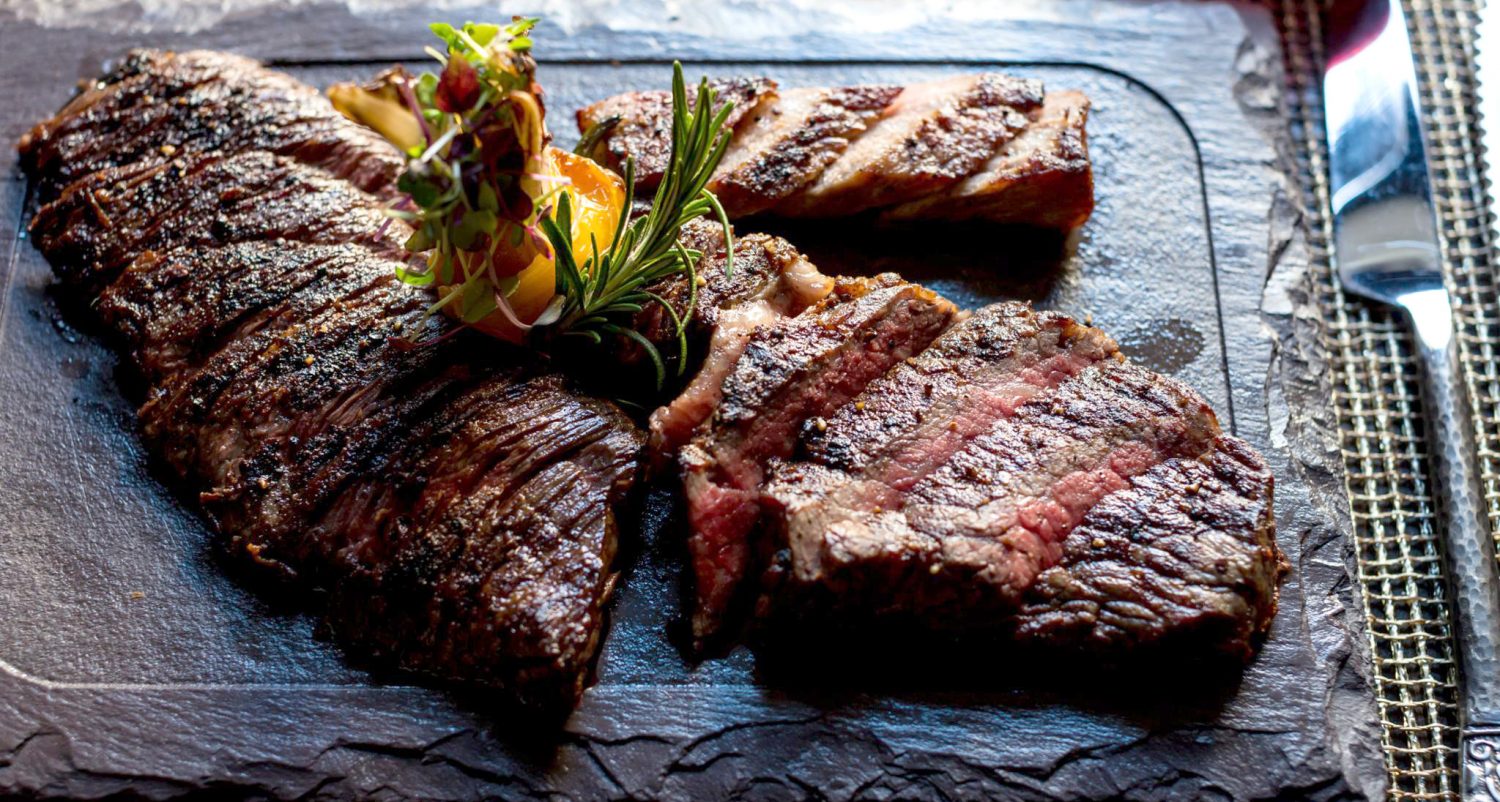
Injera, it is more than just a flatbread to eat with Ethiopian stews.
It doubles as the eating utensil/vehicle. You tear off chunks of this fluffy, pillowy flatbread/pancake and use it to scoop up the stew instead of a knife and a fork or a spoon.
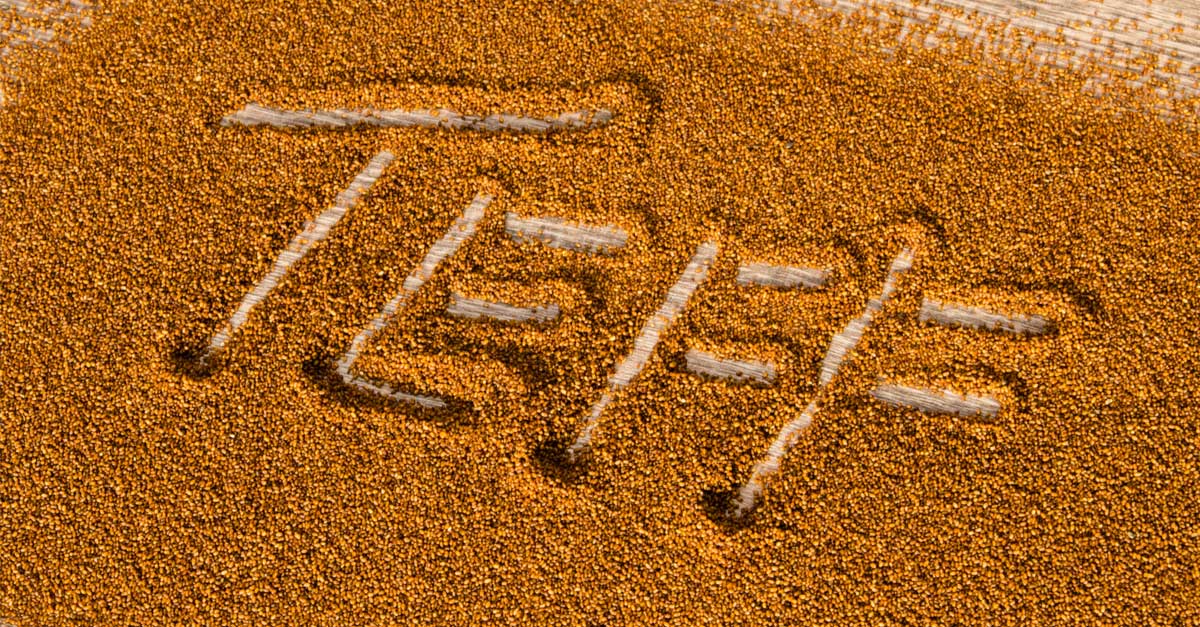 It is made from what some call one of the super grains, Teff. Following is a quote from a nutritionist on Teff.
It is made from what some call one of the super grains, Teff. Following is a quote from a nutritionist on Teff.
It has more calcium than any other grain, is a complete protein, is the size of a poppy seed, is the only ancient grain (or seed) to contain Vitamin C, is completely gluten and grain-free, and is rich in iron, magnesium, Vitamin B6, fiber, and protein. Meet tef.
On top of it, for a diabetic like me it also has a low glycemic index because what starch it has, which is pretty low to begin with, a third of it is resistant starches; further, it also has plenty of fibre in it to counteract the starches.
Enough pontification, let us talk about Injera.
Injera making is normally a pretty involved process. While it is mostly waiting for it to ferment, it still takes a couple of days, sometimes three in winter. You make a batter of Teff and water with a little bit of salt and wait for it to ferment and get bubbly. I dont tend to have the patience for it or the planning. I tend to say Ethiopian tonight and I need Injera. So I came up with the following quickfire recipe for quick Injera. Tef when it has not had the time to ferment tends to have a grainy texture and so I make a few modifications to making the batter. Also since I am not letting the thing ferment to produce the gases for the fluffy texture, I cheat with Baking powder and Club Soda.
- Cut the Teff flour with a third of Quinoa flour
- Add a little bit of regular AP flour to provide the Gluten to hold the Injera together
- Use Baking Powder and Club Soda
- Fermentation produces a slight sourness that is part of the essence of Injera and Lemon or Lime juices in the batter instead produces a harsh acidity. So I add a pinch or two sumac to the batter that produces a gentler acidity.
Ingredients:
- 2/3 Cup Tef Flour
- 1/3 Cup Quinoa Flour
- 1/4 Cup All Purpose Flour
- 2 Teaspoons Baking powder
- 1-2 Pinches of Sumac
- ~ 1 Cup Club Soda, chilled in the fridge for at least an hour
- 1/2 teaspoon of Kosher salt (adjust for taste)
Directions:
- Sift the Flours, salt, Sumac and the baking powder together to ensure even mixing
- Make a well in the center and pour in the club soda slowly while constantly whisking with a large whisk. Don’t worry, you wont degas it too much
- Add any extra needed club soda to get to the consistency of a thin pancake batter
- Meanwhile heat a non stick skillet (one for which you have a lid, glass lid preferably) over medium low to low heat on the stove
- Pour quarter cup of the batter on to the skillet while holding it tilted slightly away from you and swirl to distribute to a thin layer
- Cover with the lid so the Injera steams. You don’t really want it to brown much like a pancake. You may end up lowering the heat to low to ensure it does not cook too quickly on the bottom
- Injera is done when the top surface appears full of holes and does not look wet
- Take it off the skillet and roll it up to keep it from drying out
- Use up all of the batter
- Wipe dry the inside of the lid to the skillet between uses to remove the condensed moisture so it does not drip back on tot he Injera as it is cooking.
Serve with any of the savoury Ethiopian stews like Doro Wat, Doro Alicha, Key Wat(Beef), Beg Wat(Lamb) or Awaze Tibs (Lamb and Onion).
I actually love Injera with a spicy, sticky Indian curry as well…
Doro Wat – Say what….
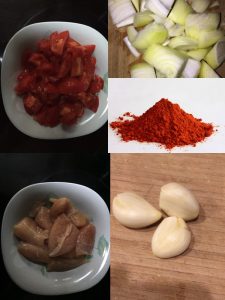 Doro Wat is a wonderfully spicy and I don’t mean “spicy hot”, but flavoursome chicken stew from Ethiopia. It uses the Berbere spice from the last post. Since the spices are robust, it is best to use chicken thighs rather than breast meat.
Doro Wat is a wonderfully spicy and I don’t mean “spicy hot”, but flavoursome chicken stew from Ethiopia. It uses the Berbere spice from the last post. Since the spices are robust, it is best to use chicken thighs rather than breast meat.
This is a dish that needs time. The Ethiopian way of slow cooking the onions brings out a sweetness to them that is unparalleled. So much so that I have taken up this as a means of cooking onions even for Indian curries etc.
 Above is a collage of the basic ingredients of this recipe. To process these as part of the mise-en-place, I used a Cuisinart stick blender with the mini chop attachment. The onions really need to be chopped very very fine, almost a pureé.
Above is a collage of the basic ingredients of this recipe. To process these as part of the mise-en-place, I used a Cuisinart stick blender with the mini chop attachment. The onions really need to be chopped very very fine, almost a pureé.
Ingredients:
- 1 medium Onion, chopped very very fine, almost a puree
- 3 large Garlic cloves, chopped fine
- 3 large Tomatoes, coarsely chopped and then pureéd in the mini chop Doing the tomato last provides the liquid to sweep up any left over, onion and garlic bits in the mini chop
- 2 1/2 Tablespoons of Berbere
- 1 lb Chicken thighs, trimmed of excess fat and cut into one and a half inch chunks.
- Olive Oil
- Butter
- Salt
Directions: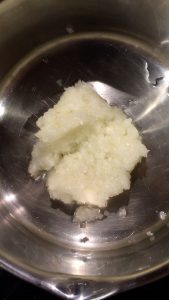
- Set a heavy bottom pan on the stove on (real) low and add a tablespoon of butter and a teaspoon or so of Olive oil to prevent the butter from burning.
- Once the butter ha melted and stopped foaming, add the on
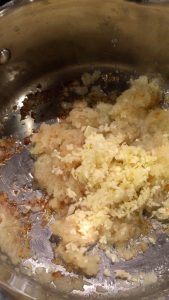 ions, stir and cover it with the lid. Spread the onions out as evenly as possible on the bottom before covering.
ions, stir and cover it with the lid. Spread the onions out as evenly as possible on the bottom before covering. - Look but don’t touch for the next 20 minutes or so. The onions will semi-steam and semi saute as the juices from them will keep them moist and prevent scorching (hence the real low)
- Add the chopped garlic, stir, add a bit more butter and or olive oil to keep everything lubricated on the bottom of the pan.
- Cover and ignore it for another 15 minutes.
- Add the Berbere, a bit more oil if it needs it, mix thoroughly cover and cook on low for another 15 minutes; follow this with the pureed tomateos and cook on low for another 20 minutes or so. In fact, the oil should separate from the sauce before you add the chicken chunks. Pictures below in sequence to show you what the various stages from above should look like.
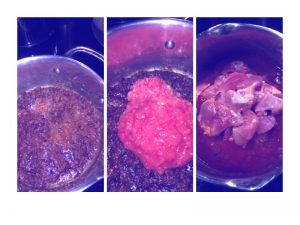
- Stir the chicken in and cover and cook on low for about 30 -45 minutes till the chicken is done. The traditional way is to also add some hard boiled eggs to the pot for the last 15 minutes or so. To make sure the flavours get into the eggs, you cut slits through the whites so the sauce can penetrate to the yolk. Cut a few slits on each egg.
- While, non traditional, I tend to sprinkle a little bit of garam masala on the top before serving.
- Serve with Injera (traditional Ethiopian flat bread made from Tef; I will post the recipe in a separate post). I served it with Injera and a quick salad of cherry tomatoes, cucumber, seasoned with some grated ginger, red wine vinegar, olive oil and parsley to provide the acidic counter point tot he unctuous chicken.
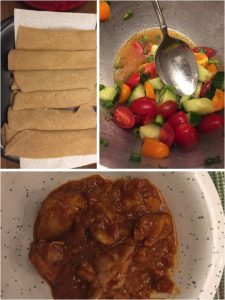
Berbere – Ethiopian Spice Mix
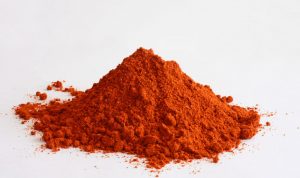
There is nothing quite that says Ethiopian food than Berbere, the ubiquitous spice mix of this land. Of course, there isn’t one recipe for Berbere. Every household will have its own variation. This one started with a recipe I got from a colleague of a couple of jobs ago, Abe Woldeselassie. This was his Grand mothers version. As is the norm with handed down spice mixes, even in Ethiopia, I added a couple of minor changes and this is what I have been using to make Doro Wat(Chicken) or Key Wat(Beef). I also love this on roasted Root vegetables (Just toss big chunks in Olive oil with the Berbere and roast them at 375-400 till done and you see some char on them).
Here is my recipe for Berbere.
Ingredients:
- 2 teaspoons coriander seeds
- 1 teaspoon cumin seeds
- ½ teaspoon fenugreek seeds
- 1 teaspoon black peppercorns
- 2 whole allspice berries
- Seeds of 4 green cardamom pods
- 4 cloves
- 5 dried red chilies, seeded, broken into small pieces‡
- 3 tablespoons sweet paprika
- 1 teaspoon salt
- ¼ teaspoon nutmeg
- ½ teaspoon ginger
- ¼ teaspoon cinnamon
- 1 teaspoon turmeric
‡ – You can find giant bags of them for cheap at your local Indian Market. Use them based on your palate. I like mine a little spicy. Use less if you are a “Blandie” 🙂
Directions:
- Using a heavy pan, I like my cast iron pan for this, toast the whole spices, including the chillies, on high heat, shaking the pan regularly to prevent scorching until they are fragrant. This usually takes 2 to 3 minutes.
- Put them in a bowl and let them cool completely.
- Grind the toasted spices fine in a coffee grinder. While the Grandmas and Mothers of Ethiopia used mortars and pestles and elbow grease, a dedicated coffee grinder is perfect and I have moved with “new technology”.
- After grinding the toasted spices fine, add the other spices already in powder form to the grinder and grind everything together for a couple of minutes.
- Store in an airtight container in a dark cabinet or pantry.
Pork Chile Verde
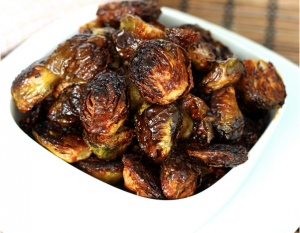
![]()
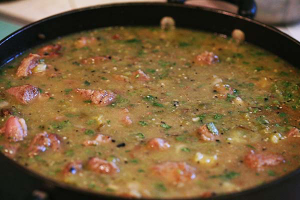
This is a classic Mexican dish with Pork and the bright acidity of the Tomatillos. This certainly calls for a good Beer to go with it and my personal favourite is, as always, Negra Modelo.
Ingredients:
- 3/4 lbs Tomatillos
- 3-4 cloves of Garlic (unpeeled) for Roasting
- 2 Jalapenos (Seeded and de-veined for the blandophiles, and leave them in if you want the heat… but of course)
- 2 Poblano chiles
- 1/2 bunch of Cilantro, rinsed and chopped
- 1 3/4 to 2 lbs Pork Shoulder cubed
- Salt and Fresh Ground Black Pepper
- 3 Cloves of Garlic finely chopped
- Olive Oil
- 1 1/2 Medium Yellow Onions chopped
- 1 1/2 Tbsp Mexican Oregano
- 1 1/2 cups Chicken Stock
- 1 Pinch of Ground Cloves
Directions:
- De-husk and chop the Tomatillos in Half
- Broil them cut side down for 5 to 10 minutes in the oven.
- Broil the unpeeled garlic cloves and the Poblano peppers separately and squeeze out the garlic from the husk and steam and
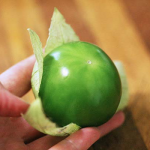 remove the skin as well as the seeds and the veins from the Poblano peppers.
remove the skin as well as the seeds and the veins from the Poblano peppers. - Blend the broiled tomatillos with the garlic, Poblano and
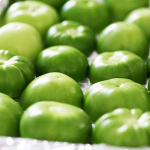 the Jalapeno peppers and the Chopped Cilantro.
the Jalapeno peppers and the Chopped Cilantro. - Generously season the cubed pork with salt and pepper and sear them in a heavy bottomed skillet with the Olive oil to brown them on
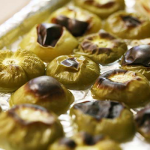 all sides. Work in batches if need be to not crown the pan and lead to steaming the pork rather than searin
all sides. Work in batches if need be to not crown the pan and lead to steaming the pork rather than searin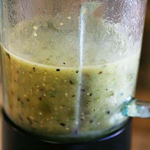 g it. Remove with a slotted spoon and set aside.
g it. Remove with a slotted spoon and set aside. - Pour off most of the residual fat and saute the onions and the garlic till wilted and fragrant.
- Add back the Pork the pureed tomatillo sauce, the
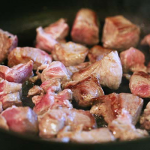 oregano, and the pinch of cloves. Add a little bit more salt and pepper for seasoning. Be careful here since the sauce is going to concentrate a bit.
oregano, and the pinch of cloves. Add a little bit more salt and pepper for seasoning. Be careful here since the sauce is going to concentrate a bit. - Add enough stock to cover the meat.
- Bring to a boil and reduce to a real low simmer and cook on the stove between 2 and 3 hours until the pork is fork tender.
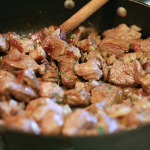
Serve with Mexican style dirty rice and fresh corn tortillas….
Keep the Negra Modelo at hand
Middle Eastern Style Salad
This is a little salad I put together to go with a Moroccan style chicken Breast cutlets. I have that separately posted. Here is the link to Chicken – Pseudo Moroccan.
- I started by seeding and chopping tomatoes into about ha
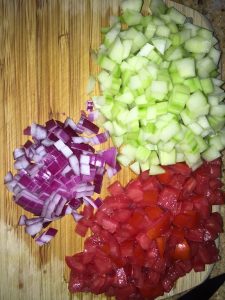 lf inch dice.
lf inch dice. - Peel, Seed and chop English cucumber, about 1/2 of a large one. Keep the size about the same as the Tomato.
- I also washed and cleaned and chopped reasonably fine one heart of Romaine lettuce.
- Finely dice about 1/5 of a medium size Red Onion.
- Do a Chiffonade of Fresh mint about a quarter of a cup.
- Toss all of these into a bowl.
What I needed at this point was really some Tahini. I did not have any but I had some hummus (good one, made by Ed Hyders a local Mediterranean food source here in Worcester, MA). I used that instead of Tahini
- A mixture of Hummus, Lime juice, Olive Oil, Salt and Pepper to make a dressing.
- What was funny was a secondary positive of the Hummus instead of Tahini; the extra protein from the chick peas made the emulsification of the dressing easy.
- Taste and adjust. It needs the acidity but careful not to overwhelm the mint with the acid.
- As a last and almost light bulb moment, where I wanted a more pronounced lemony flavour without adding too much acid, I sprinkled in some Sumac.
Don’t be a stickler, doesn’t everybody have dried Sumac in their Pantry anyway. 🙂
Chicken – Pseudo Moroccan
 I needed a quick cooking chicken recipe for a summer day when most of it happened on the outside grill. I wanted something from the Middle East, may be Morocco or thereabouts.
I needed a quick cooking chicken recipe for a summer day when most of it happened on the outside grill. I wanted something from the Middle East, may be Morocco or thereabouts.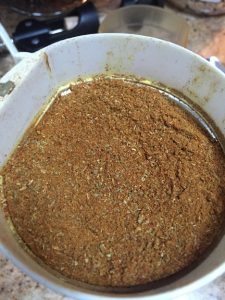
- 1 teaspoon Cumin Seeds
- 1 teaspoon Coriander seeds
- 1 teaspoon Fennel Seeds
Toast all of these over Medium heat till they are fragrant. Cool and grind fine in a coffee grinder that you have dedicated to grind spices… You have one of these don’t you?? You can always resort to a mortar and pestle and elbow grease… Mix in
the following
- 1 teaspoon of Cayenne pepper (adjust down or up based on your preferences)
- 1/2 teaspoon of turmeric powder.
- Lay the chicken breast cutlets out on a Foil lined plate.
- Drizzle Olive oil over the chicken and rub to coat.
- Season the chicken with salt and a few grinds of pepper.
- Sprinkle the spice mixture evenly over the oiled chicken pieces on both sid
 es and let them rest for 15 minutes on the counter top.
es and let them rest for 15 minutes on the counter top. - Turn on the grill and get it heated to medium hot.
- Grill the chicken pieces quickly over the hot grill. It should not take more than a minute per side. I find that cooking is a lot more even if you move the chicken to an unused spot on the grill when flipping so you don’t get a lowered temperature
from the old cooking spot.
Rest the chicken for a few minutes for the juices to re distribute in the meat. Squeeze fresh lemon juice over the chicken and serve with some good Pita Bread and a Middle Eastern Salad. We did not do it last night when we had this dish, but I think a Spanish Albariño would go splendidly with this one.
An Experiment in Recreation – Bottarga
Bottarga – An Italian ingredient that I love but cannot really afford it as much as I want to.
I was thinking about what Bottarga is; well it is smoked cakes of dried fish roe that you grate over some fresh Pasta or may be silky potato puree. But in a functional description, it adds a rich flavour because of its Protein content, fishy (not everybody likes the fishiness), salty, a little smoky and it tends to have a touch of acidity (mild and not over powering).
So, I thought I could try and recreate it without the fish roe. Here comes another of Natures greatest Protein sources, the humble egg. Here is what I did and I will post the results once I taste it.
- Four Organic Cage free Eggs local farm store. If this works right, I may have to go find a local farmer who can give me a bunch of it since I have plans for this.
- Got a Tupperware 6 inch square and layered about 2/3 cup of Kosher salt. I used Diamond Crystal since I had it at home. I don’t think it matters what brand but you don’t want it too coarse; that leads to reduction of contact with the egg. Too fine and it may get too salty from too much contact.
- Made four divots in the salt with my fingers.
- Separated th
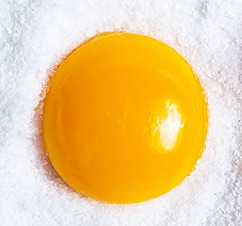 e Yolks from the whites with my hands, taking care to get as much of the stringy extra membranous bits without breaking the membrane and releasing the yolk to run.
e Yolks from the whites with my hands, taking care to get as much of the stringy extra membranous bits without breaking the membrane and releasing the yolk to run. - Laid each of the yolks in the divots. Used another 2/3 cup of salt to cover the yolks completely. Loosely put the lid on top and shoved it into the back corner of the fridge. The salt has to pull out the moisture from the yolk.
Three days later…
- The yolks look gelatinous. They are still a little soft at this point since a lot of moisture has been pulled out but they are not quite dry. A good time to get the a
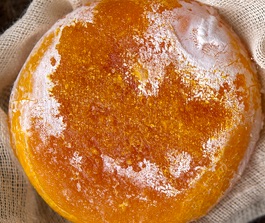 cidity on to them
cidity on to them - Took some white balsamic vinegar and diluted it by half. Used this vinegar to wash off the salt while gently scrubbing with fingers taking care not to break or scratch the surface of these yolks.
- Layered them on top of a fine mesh cooling grate that fitted in side a Tupperware and put that in the fridge again. Loosely covered the top with a Paper towel; nothing was touching the yolks. This was to dry the yolks further and get them ready for smoking.
- I flipped the yolks after two days to expose the surface in contact with the grate to dry better and left them alone for two more days.
Four days pass… Just forget that they are in your fridge.
- I need to smoke these dried egg yolks. They are dry but not hard crackly dry due to their protein content.
- Set a metal dish on top of the stove, added some Alder wood chips (that is what I had in the garage). Turned the burner to medium under them. When they started smoking, turned the heat down to maintain the smoke but take away the excess heat so you don’t cook the yolks. Inverted a clear Tupperware so I could see the smoke and let them sit in the smoke for about 10 minutes.
- Took them off and lay them not touching each other on top of a coffee filter lining a little plastic Tupperware. Layered a couple of more coffee filters to loosely cover them and they are sitting on my counter. Today is saturday and they have been going two days. I will wait one more day and them I am going to grate them with a microplane and taste them.
They look like Bottarga cakes except they are ovoid rather than the pressed squared off Bottarga cakes you can get at an enormous price at the fancy italian grocery store.
I will tell you what the taste test comes out like tomorrow…
Update: They were absolutely brilliant grated over fresh pasta
Roots – A restaurant in Rutland, Vermont
 We went for dinner during our vacation in July to a restaurant named “Roots – The Restaurant” in Rutland, VT. The food was not bad… But I had some issues with the place overall. We ordered a Cheese platter for appetizer. The cheese was not warmed up to Room Temperature. A cold Brie at Fridge temp just does not go far in my mind. The cheese itself was good but when it is fridge cold it does not work. Neither did the blue cheese or the aged goat
We went for dinner during our vacation in July to a restaurant named “Roots – The Restaurant” in Rutland, VT. The food was not bad… But I had some issues with the place overall. We ordered a Cheese platter for appetizer. The cheese was not warmed up to Room Temperature. A cold Brie at Fridge temp just does not go far in my mind. The cheese itself was good but when it is fridge cold it does not work. Neither did the blue cheese or the aged goat
cheese. An hour on the sideboard would have done these cheeses a world of good. Well, I ordered a Verdejo to go with my seared scallops main course, The seared scallops dish itself was very well done. The roasted beets were wasted on the plate. The mixed wild mushroom duxelles with shitake, maitake, oyster and woodear was very nice except for a couple of pieces of grit that managed to sneak through. Well I also had a problem with a 3Oz pour of the Verdejo at 9$ a glass. All in all it was an average experience with the value for money being on the low side.
DISCLAIMER: This is a resurrected Post and the review was from mid 2015. Let us not forget that it may be a completely different restaurant now and might just be spectacular.
Mise en Place and why is it so important?
“Mise en Place” is fancy French for Cooking Prep work. Literally it means “Put in Place”. This covers all of the putting in place of ingredients ready to cook. The following steps cover “Mise en Place”.
- Collect all of the ingredients needed for the dish
- Measure out the appropriate quantities needed
- Cut, chop, dice, julienne, brunoise appropriate ingredients.
Sometimes a Mise en Place might actually entail cooking something. For example a Green bean salad with almonds may call for blanched green beans and roasted slivered almonds; this means there is the cooking process of blanching the green beans and shocking them to stop the cooking before your Mise en Place for the salad is complete.
So Mise en Place for one dish might spawn other Mise en Places recursively. C’est La Vie… I cannot overstate the importance of this process. Getting everything ready just makes the cooking go faster, smoother and you don’t forget that last ingredient that needed to be added and in your hurry as the stove is going and you want to avoid overcooking something you miss adding it. Ergo, it is worth the extra minutes to put everything in its place…
An Example Mise en Place for a Paella from the website Passport dinners below to demonstrate

A Wine Rating System for a Pleb like me..
 This is a simplistic wine rating system for me. A Robert Parker 98 means really nothing to most mortals who like to drink good wine.
This is a simplistic wine rating system for me. A Robert Parker 98 means really nothing to most mortals who like to drink good wine.
This is my way of categorizing my wines based on my drinking…
-
- WTIB – This is “Wow Take it Back”, meaning take it back to the kitchen. This lot of riff raff don’t deserve this and let us drink it just by ourselves without sharing.
- ONGM – “Oooohh, nice; Get some more”
- GW – Easy rating… Stands for “Good Wine”. A lot of every days wines fall under this category. There are exceptions of course
- YWE – “Yeah Whatever”. Nothing exceptional but will do at a pinch…..
- EwwP – “Ewwww, Plonk”. Have not drunk something like this since college. Would not put it out even after everybody at the party is drunk enough to kill their taste buds.


